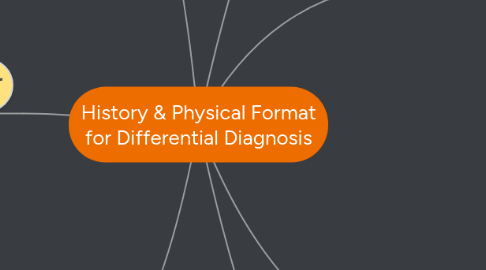
1. 1. Chief Complaint
1.1. HISTORY OF PRESENT ILLNESS (HPI)
1.1.1. ONLY deals with the circumstances & symptomatology, leading up to the Chief Complaint. DO NOT MIX with Past Medical Hx which is UNRELATED. IF PMHx is Related, then, you can say so here.
2. 6. PLAN OF CARE
2.1. TREAT
2.2. REFER
2.3. TREAT & REFER
3. 7. RE-ASSESSMENT
3.1. ARE YOU SUCCESSFUL IN YOUR TREATMENT?
3.1.1. SYMPTOMS GETTING BETTER
3.2. ARE YOU UNSUCCESSFUL IN YOUR TREATMENT? i.e. Negative Outcomes
3.2.1. NO CHANGE IN SYMPTOMS
4. PERCEPTUAL DIFFERENTIAL DIAGNOSIS OCCURS AT THESE NODES (see #4 at the external arrow link here)
5. 2. HISTORY
5.1. HPI (History of Present Illness)
5.1.1. This reflects the History of Present Illness - How did the current Chief Complaints come about?
5.2. This IS "THEIR" STORY - Do NOT confuse with History of Present Illness (HPI). This History has no direct correlation with Chief Complaint or HPI
5.2.1. Past Medical
5.2.2. Past Surgical
5.2.3. Medications
5.2.4. Allergies
5.2.5. SOCIAL Hx
5.2.5.1. Habits Hx
5.2.5.1.1. Tobacco
5.2.5.1.2. ETOH
5.2.5.1.3. Street Drugs / Illicits
5.2.5.2. Home / Geographic
5.2.5.3. Support System
5.2.6. Special Histories
5.2.6.1. Menstrual
5.2.6.2. Gravida / Para
5.2.6.3. Sexual
5.2.6.3.1. Partners
5.2.6.3.2. Protected or Unprotected Sex
5.2.6.4. Others
5.2.7. REVIEW OF SYSTEMS
5.2.7.1. SUBJECTIVE - "YES / NO" Questions
5.2.7.1.1. PAIN - THIS IS WHERE YOU OBTAIN SUBJECTIVE PAIN DATA - Decide Which of the following systems it might correlate with? Plan on examining THAT system in Physical Exam --> Systems Review
5.2.7.1.2. HEENT
5.2.7.1.3. CARDIOVASCULAR
5.2.7.1.4. PULMONARY
5.2.7.1.5. NEUROLOGIC
5.2.7.1.6. MUSCULOSKELETAL
5.2.7.1.7. INTEGUMENTARY
5.2.7.1.8. ABDOMEN
5.2.7.1.9. OTHERS
5.3. Review of Systems (ROS) - open attached file.
6. 3. PHYSICAL EXAM
6.1. VITALS
6.1.1. BP
6.1.2. HR
6.1.3. RR
6.1.4. Temp
6.1.5. O2 Sats
6.2. GENERAL OBSERVATION (L@@K ONLY)
6.2.1. How does the patient appear to you?
6.2.1.1. Keywords:
6.2.1.1.1. Well noursished
6.2.1.1.2. Thinly built
6.2.1.1.3. Cachectic
6.2.1.1.4. Deformities - If Obvious
6.2.1.1.5. In Distress
6.2.1.1.6. No Apparent Distress
6.3. SYSTEMS REVIEW (OBJECTIVE EXAM FOR DATA COLLECTION)
6.3.1. HEENT
6.3.2. CARDIAC & PULMONARY
6.3.2.1. Local Inspection
6.3.2.1.1. Neck
6.3.2.1.2. Chest
6.3.2.2. Palpation
6.3.2.2.1. Liver Border Palpation to see if Enlarged (R heart failure cardinal sign)
6.3.2.2.2. Traube's Space
6.3.2.3. Percussion
6.3.2.4. Auscultation
6.3.2.4.1. Heart Sounds
6.3.2.4.2. Lung Sounds
6.3.2.5. Functional Exam
6.3.2.5.1. CV Conditioning
6.3.2.5.2. BP Response to Positional Change & Exercise
6.3.3. NEUROLOGIC
6.3.3.1. Higher Functions (CN/Cognition/Memory)
6.3.3.2. Motor
6.3.3.2.1. Tone
6.3.3.3. Reflexes
6.3.3.3.1. Superficial
6.3.3.3.2. Deep
6.3.3.4. Coordination
6.3.3.4.1. FTN/HST/RAM-Diadochokinesia
6.3.3.5. Sensation
6.3.3.5.1. Pain/Touch/Temperature
6.3.3.5.2. Proprioception
6.3.4. MUSCULOSKELETAL
6.3.4.1. LOOK
6.3.4.1.1. Deformities
6.3.4.1.2. Erythema
6.3.4.1.3. Aberrations
6.3.4.2. FEEL
6.3.4.2.1. Strength
6.3.4.2.2. Swelling, Lumps or Bumps
6.3.4.3. MOVE
6.3.4.3.1. ROM
6.3.4.3.2. Flexibility
6.3.4.4. Special Tests - See below:
6.3.5. INTEGUMENTARY
6.3.6. ABDOMINAL EXAM
6.3.6.1. LIVER Borders
6.3.6.2. DIAPHRAGM BORDER
6.3.6.3. QUADRANT EXAM
6.3.6.3.1. Tenderness
6.3.6.3.2. Lumps / Tumors
6.3.6.4. TRAUBE'S SPACE
6.3.6.5. SPLEEN
6.3.6.5.1. CASTELL'S SIGN
6.3.6.6. SPECIAL TESTS - SEE BELOW
6.4. Special Tests & Measures (When Documenting - these should be part of the individual systems that you perform in Systems Review
6.4.1. Orthopedic
6.4.1.1. Joints
6.4.1.1.1. Shoulder & Arm
6.4.1.1.2. Elbow
6.4.1.1.3. Wrist & Hand
6.4.1.1.4. Knee
6.4.1.1.5. Hip
6.4.1.2. Regions
6.4.1.2.1. Back
6.4.1.2.2. Abdomen - See below
6.4.2. Abdominal
6.4.2.1. Signs of Hernia
6.4.2.1.1. R UQ
6.4.2.1.2. Inguinal
6.4.2.2. Inguinal Lymph Nodes
6.4.2.3. Liver Borders
6.4.2.4. Gall bladder
6.4.2.5. Spleen
6.4.2.6. Aorta
6.4.2.7. Femoral Artery
6.4.2.8. Psoas Sign - Obraztsova's sign - Cope's Psoas Sign
6.4.2.9. Blumberg's Sign - Rebound Tenderness
6.4.2.10. Rovsing's Sign
6.4.2.11. McBurney's Point (Point of Max Tenderness in Appendicitis)
6.4.3. Cardiovascular
6.4.4. Pulmonary
6.4.5. Integumentary
6.4.6. Neurologic
7. 4. Investigations & Imaging
7.1. LAB REPORTS
7.1.1. ALWAYS BE SPECIFIC as to WHAT LAB VALUE IS OF INTEREST in a given case. Haphazard looking at Lab Reports is UNwarranted.
7.1.1.1. For Example, in a patient with bleeding (from anywhere), Look for Hemoglobin. Why? Because Low Hemoglobin is a cause for Exercise Intolerance, which is interpreted by Patients as "Weakness" for which PT is referred.
7.2. IMAGING REPORTS
7.2.1. X-Rays & CT Scans
7.2.1.1. These are Ionizing Radiations
7.2.1.1.1. If requesting these studies, think: DOES THIS PATIENT TRULY NEED EXPOSURE TO IONIZING RADIATION?
7.2.2. MRIs
7.2.3. Ultrasounds
7.2.4. PET
7.2.5. SPECT
7.2.6. Others
8. 5. ASSESSMENT - the SYNTHESIS of ALL the data collected
8.1. WHAT ARE THE MAJOR PROBLEMS? - Attempt to answer the "WHY" did these problems occur in the first place?
8.1.1. Keywords:
8.1.1.1. Weakness
8.1.1.2. Pain
8.1.1.3. Functional Impairments
8.1.1.3.1. Inability to Move
8.1.1.3.2. Inability to Walk
8.1.2. PROCESS OF DIFFERENTIAL - For EACH of the above problems - "WHAT" are (ALL) the POSSIBLE CAUSES?
8.1.2.1. Deal with each problem and narrow down the actual cause eg: Gait difficulty - acute amputation of the R LE
8.1.3. Do YOU EVEN KNOW THE CAUSE? IF NOT WHAT ARE THE NEXT STEPS - SHOULD YOU TREAT EMPIRICALLY? OR SHOULD YOU TREAT SPECIFICALLY?
8.1.3.1. ELIMINATE every cause that is not contributory to the problem that you can in your scope of practice
8.2. IS the Cause of the Problem Remediable by PT?
8.2.1. This is a scope of practice issue
